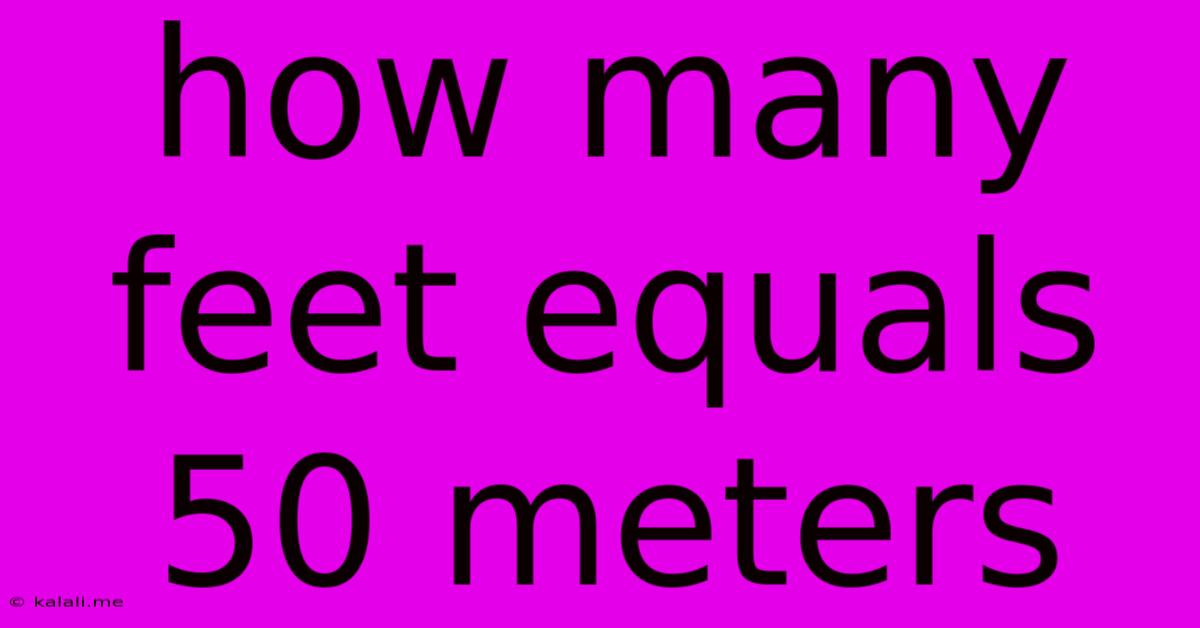How Many Feet Equals 50 Meters
Kalali
May 09, 2025 · 3 min read

Table of Contents
How Many Feet Equal 50 Meters? A Comprehensive Guide
Meta Description: Wondering how many feet are in 50 meters? This guide provides a clear conversion, explores the history of measurement systems, and offers practical applications for this conversion. Learn the simple formula and avoid common conversion mistakes.
Converting between metric and imperial units can sometimes feel like navigating a maze. One common query is: how many feet are in 50 meters? This seemingly simple question actually opens the door to understanding fundamental concepts in measurement and unit conversion. This article will provide the accurate conversion, explain the process, and offer real-world examples where this knowledge might be useful.
Understanding the Conversion Factor
The key to converting between meters and feet lies in understanding the conversion factor. One meter is approximately equal to 3.28084 feet. This means that to convert meters to feet, you simply multiply the number of meters by 3.28084.
Therefore, 50 meters is equal to:
50 meters * 3.28084 feet/meter ≈ 164.042 feet
For most practical purposes, rounding to 164 feet is perfectly acceptable. However, for precise calculations, especially in engineering or construction, using the more accurate figure of 164.042 feet is recommended.
A Brief History of Measurement Systems
The difference in units stems from the historical development of two distinct measurement systems: the metric system (based on meters, liters, and grams) and the imperial system (using feet, inches, gallons, and pounds). The metric system, based on powers of 10, is now the internationally preferred system, while the imperial system remains prevalent in some countries, including the United States. Understanding the historical context helps to appreciate the need for accurate conversions.
Practical Applications of Meter-to-Foot Conversion
Knowing how to convert 50 meters to feet (and vice versa) has several practical applications:
- Construction and Engineering: Building plans often use both metric and imperial units. Converting between them ensures accuracy and prevents costly mistakes.
- Sports and Athletics: Many sports use different units in different countries. Converting measurements, such as track lengths or field dimensions, ensures consistency in reporting and comparison.
- Real Estate: Property measurements might be given in either meters or feet, requiring conversion for accurate comparisons.
- Travel: Understanding unit conversions is crucial when navigating distances and measurements in different countries.
- Gardening and Landscaping: Planning garden layouts or landscaping projects might involve using both systems, necessitating accurate conversion.
Avoiding Common Conversion Mistakes
- Using the wrong conversion factor: Ensure you're using the correct conversion factor of approximately 3.28084 feet per meter.
- Incorrect rounding: While rounding is often necessary, be mindful of the level of precision required for the specific application.
- Mixing units: Always keep units consistent throughout your calculations. Avoid mixing meters and feet within the same equation.
Conclusion
Converting 50 meters to feet is a straightforward process once you understand the conversion factor. Remember to use the correct factor (approximately 3.28084 feet/meter) and consider the required level of precision for your specific application. This simple conversion holds significant practical value across a wide range of fields. Mastering this skill enhances your ability to work with different measurement systems effectively.
Latest Posts
Latest Posts
-
How Can A Renewable Resource Become Nonrenewable
May 09, 2025
-
Standard Form Of A Polynomial Definition Math
May 09, 2025
-
How To Convert 6 11 To A Decimal
May 09, 2025
-
How Much Is 17 Oz In Cups
May 09, 2025
-
3 5 Grams Equals How Many Ounces
May 09, 2025
Related Post
Thank you for visiting our website which covers about How Many Feet Equals 50 Meters . We hope the information provided has been useful to you. Feel free to contact us if you have any questions or need further assistance. See you next time and don't miss to bookmark.